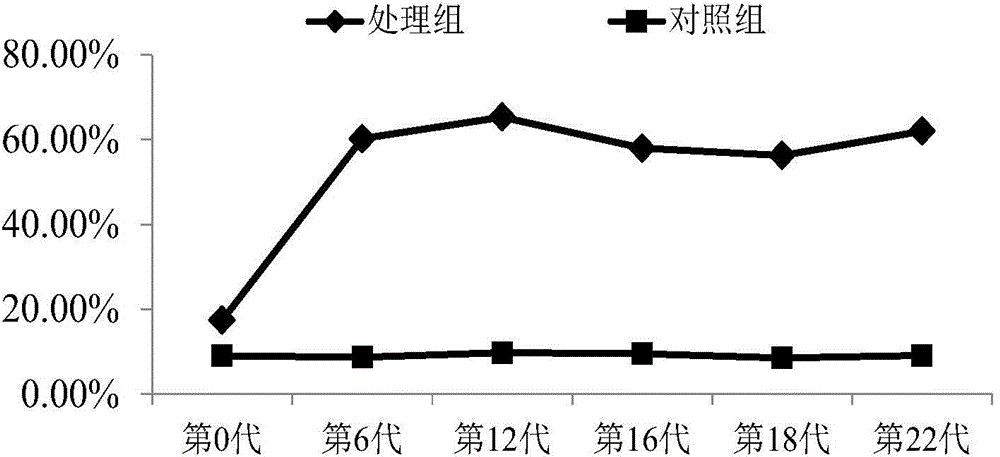Saline-alkaline tolerant microbial flora and applications thereof
A salt-alkali-tolerant, microbial activity technology, applied in microorganisms, microorganism-based methods, biological sludge treatment, etc., can solve the problems of no large-scale application precedent, immature technology and process, technical bottleneck, etc., and achieve low production costs. , the effect of fast bacterial growth rate and extensive adaptability
- Summary
- Abstract
- Description
- Claims
- Application Information
AI Technical Summary
Problems solved by technology
Method used
Image
Examples
Embodiment 1
[0015] Example 1: Identification of original microbial community structure and pollutant analysis of waste drilling mud
[0016] Using the method of 16S rDNA clone library, the original microbial community structure in the waste drilling mud piled up near the port 356 well site in Dagang Oilfield, Tianjin, China was analyzed, which was used to screen the salt-alkali tolerant functional microbial community and optimize the culture conditions. The results showed that Pseudomonas sp. accounted for the highest proportion in the waste drilling mud, reaching 27.44%; Rhizobium sp. and Rhodobacter sp. also accounted for a higher proportion, respectively 20.73% and 8.54%. The proportion of Dethiobacter alkaliphilus in the community is 7.93%, which is directly related to the high sulfur content in the waste drilling mud.
[0017] The basic physical and chemical properties of the waste drilling mud were analyzed, and it was found that the pH of the waste drilling mud was 8.2-8.5, the pe...
Embodiment 2
[0018] Example 2: Screening of saline-alkali-tolerant active flora and analysis of community structure
[0019] The activity characteristics of the saline-alkali-tolerant active microbial flora depend on the particularity of its growth environment and the environmental tolerance obtained from long-term domestication. The following methods are used to screen the saline-alkaline-tolerant microbial flora.
[0020] 1. Preparation of culture medium: according to the ratio of 100g / L, weigh waste drilling mud and inoculate it into a 500mL Erlenmeyer flask prepared in advance with 200ml of crude oil inorganic salt medium containing 2% (w / v) and mix well, 180rpm, 30°C Shaking culture, the medium composition is as follows (w / v): potassium dihydrogen phosphate 0.005%, dipotassium hydrogen phosphate 0.005%, ammonium nitrate 0.005%, magnesium sulfate 0.0025%, calcium chloride 0.005%, ferrous sulfate 0.0005%, with 5% solid additives, 5% no solid phase additives, pH 7.5, low organic carbon s...
Embodiment 3
[0023] Example 3: Verification of the function of active flora by compounding single bacteria
[0024] According to the ratio of the active functional flora screened in Example 2, respectively select Alishewanella fetalis isolated from mud samples, CGMCCC No.1.8064, and Alishewanella agri isolated from soil samples, CGMCCC No.1.10668, Pseudomonas xiamenensis isolated from activated sludge samples, CGMCCC No.1.6446, Halomonas xianhensis isolated from oil-contaminated soil samples, CGMCCC No.1.6848 and isolated from high-saline soil samples Halomonas climberi, Halomonas ventosae, CGMCCC No.1.6331, cultured in LB medium to logarithmic growth phase, after which the cell concentration was adjusted according to Alishewanella: Pseudomonas: Halomonas Bacteria Halomonas=4:3:1 ratio to form the microbial flora. The addition ratio of the different species of Alishewanella and Halomonas can be arbitrary.
[0025] According to the activity detection method described in Example 2, the cru...
PUM
 Login to View More
Login to View More Abstract
Description
Claims
Application Information
 Login to View More
Login to View More - R&D
- Intellectual Property
- Life Sciences
- Materials
- Tech Scout
- Unparalleled Data Quality
- Higher Quality Content
- 60% Fewer Hallucinations
Browse by: Latest US Patents, China's latest patents, Technical Efficacy Thesaurus, Application Domain, Technology Topic, Popular Technical Reports.
© 2025 PatSnap. All rights reserved.Legal|Privacy policy|Modern Slavery Act Transparency Statement|Sitemap|About US| Contact US: help@patsnap.com


